| Revision as of 21:41, 1 August 2023 editApokryltaros (talk | contribs)Autopatrolled, Extended confirmed users, Pending changes reviewers, Rollbackers79,972 editsm Reverted edits by 139.228.86.237 (talk) to last version by EhrenkaterTag: Rollback← Previous edit | Revision as of 19:11, 8 August 2023 edit undo80.194.237.230 (talk) →Obligate endosymbiotic bacteriaNext edit → | ||
| Line 13: | Line 13: | ||
| The genome of '']'', a ] of the European pest leafhopper, '']'', consists of a ] of 112,031 base pairs.<ref>{{cite journal|last1=Bennett|first1=Gordon M.|last2=Abbà|first2=Simona|last3=Kube|first3=Michael|last4=Marzachì|first4=Cristina|title=Complete Genome Sequences of the Obligate Symbionts 'Candidatus Sulcia muelleri' and "Ca. Nasuia deltocephalinicola" from the Pestiferous Leafhopper Macrosteles quadripunctulatus (Hemiptera: Cicadellidae)|journal=Genome Announcements|date=25 February 2016|volume=4|issue=1|pages=e01604–15|doi=10.1128/genomeA.01604-15|language=en|issn=2169-8287|pmc=4722273|pmid=26798106}}</ref> | The genome of '']'', a ] of the European pest leafhopper, '']'', consists of a ] of 112,031 base pairs.<ref>{{cite journal|last1=Bennett|first1=Gordon M.|last2=Abbà|first2=Simona|last3=Kube|first3=Michael|last4=Marzachì|first4=Cristina|title=Complete Genome Sequences of the Obligate Symbionts 'Candidatus Sulcia muelleri' and "Ca. Nasuia deltocephalinicola" from the Pestiferous Leafhopper Macrosteles quadripunctulatus (Hemiptera: Cicadellidae)|journal=Genome Announcements|date=25 February 2016|volume=4|issue=1|pages=e01604–15|doi=10.1128/genomeA.01604-15|language=en|issn=2169-8287|pmc=4722273|pmid=26798106}}</ref> | ||
| The genome of '']'' is |
The genome of '']'' is 491 Kbp nucleotides long. | ||
| === ''Pelagibacter ubique'' === | === ''Pelagibacter ubique'' === | ||
Revision as of 19:11, 8 August 2023
List of microorganisms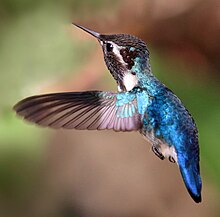
The smallest organisms found on Earth can be determined according to various aspects of organism size, including volume, mass, height, length, or genome size.
Given the incomplete nature of scientific knowledge, it is possible that the smallest organism is undiscovered. Furthermore, there is some debate over the definition of life, and what entities qualify as organisms; consequently the smallest known organism (microorganism) is debatable.
Microorganisms
Obligate endosymbiotic bacteria
The genome of Nasuia deltocephalinicola, a symbiont of the European pest leafhopper, Macrosteles quadripunctulatus, consists of a circular chromosome of 112,031 base pairs.
The genome of Nanoarchaeum equitans is 491 Kbp nucleotides long.
Pelagibacter ubique

Pelagibacter ubique is one of the smallest known free-living bacteria, with a length of 370 to 890 nm (0.00037 to 0.00089 mm) and an average cell diameter of 120 to 200 nm (0.00012 to 0.00020 mm). They also have the smallest free-living bacterium genome: 1.3 Mbp, 1354 protein genes, 35 RNA genes. They are one of the most common and smallest organisms in the ocean, with their total weight exceeding that of all fish in the sea.
Mycoplasma genitalium
Mycoplasma genitalium, a parasitic bacterium which lives in the primate bladder, waste disposal organs, genital, and respiratory tracts, is thought to be the smallest known organism capable of independent growth and reproduction. With a size of approximately 200 to 300 nm, M. genitalium is an ultramicrobacterium, smaller than other small bacteria, including rickettsia and chlamydia. However, the vast majority of bacterial strains have not been studied, and the marine ultramicrobacterium Sphingomonas sp. strain RB2256 is reported to have passed through a 220 nm (0.00022 mm) ultrafilter. A complicating factor is nutrient-downsized bacteria, bacteria that become much smaller due to a lack of available nutrients.
Nanoarchaeum

Nanoarchaeum equitans is a species of microbe 200 to 500 nm (0.00020 to 0.00050 mm) in diameter. It was discovered in 2002 in a hydrothermal vent off the coast of Iceland by Karl Stetter. A thermophile that grows in near-boiling temperatures, Nanoarchaeum appears to be an obligatory symbiont on the archaeon Ignicoccus; it must be in contact with the host organism to survive. Guinness World Records recognizes Nanoarchaeum equitans as the smallest living organism.
Eukaryotes (Eukaryota)
Prasinophyte algae of the genus Ostreococcus are the smallest free-living eukaryote. The single cell of an Ostreococcus measures 800 nm (0.00080 mm) across.
Viruses
Some biologists consider viruses to be non-living because they lack a cellular structure and cannot metabolize by themselves, requiring a host cell to replicate and synthesize new products. Some hold that, because viruses do have genetic material and can employ the metabolism of their host, they can be considered organisms. Also, an emerging concept that is gaining traction among some virologists is that of the virocell, in which the actual phenotype of a virus is the infected cell, and the virus particle (or virion) is merely a reproductive or dispersal stage, much like pollen or a spore.
The smallest viruses in terms of genome size are single-stranded DNA (ssDNA) viruses. Perhaps the most famous is the bacteriophage Phi-X174 with a genome size of 5,386 nucleotides. However, some ssDNA viruses can be even smaller. For example, Porcine circovirus type 1 has a genome of 1,759 nucleotides and a capsid diameter of 17 nm (1.7×10 mm). As a whole, the viral family geminiviridae is about 30 nm (3.0×10 mm) in length. However, the two capsids making up the virus are fused; divided, the capsids would be 15 nm (1.5×10 mm) in length. Other environmentally characterized ssDNA viruses such as CRESS DNA viruses, among others, can have genomes that are considerably less than 2,000 nucleotides.
The smallest RNA virus in terms of genome size is phage BZ13 strain T72 at 3,393 nucleotides length. Viruses using both DNA and RNA in their replication (retroviruses) range in size from 7,040 to 12,195 nucleotides. The smallest double-stranded DNA viruses are the hepadnaviruses such as hepatitis B, at 3.2 kb and 42 nm (4.2×10 mm); parvoviruses have smaller capsids, at 18–26 nm (1.8×10–2.6×10 mm), but larger genomes, at 5 kb. It is important to consider other self-replicating genetic elements, such as satelliviruses, viroids and ribozymes.
Animals (Animalia)
Several species of Myxozoa (obligately parasitic cnidarians) never grow larger than 20 μm (0.020 mm). One of the smallest species (Myxobolus shekel) is no more than 8.5 μm (0.0085 mm) when fully grown, making it the smallest known animal.
Molluscs (Molluska)
Bivalvia
The shell of the nut clam Condylonucula maya grows 0.54 mm (0.021 in) long.
Gastropods (Gastropoda)
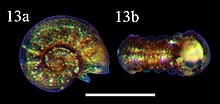
The smallest water snail (of all snails) is Ammonicera minortalis in North America, originally described from Cuba. It measures 0.32 to 0.46 mm (0.013 to 0.018 in).
The smallest land snail is Acmella nana. Discovered in Borneo, and described in November 2015, it measures 0.7 mm (0.028 in). The previous record was that of Angustopila dominikae from China, which was reported in September 2015. This snail measures 0.86 mm (0.034 in).
Cephalopods (Cephalopoda)
Further information: Cephalopod sizeMaximites was the smallest known ammonoid. Adult specimens reached only 10 mm (0.39 in) in shell diameter.
Arthropods (Arthropoda)
Arachnids (Arachnida)
- There is a debate about which spider is smallest. According to Guinness World Records, "Two contenders are from the Symphytognathidae genus Patu: males of Patu digua described in Colombia had a body length of 0.37 millimetres (0.015 inches), while the Samoan moss spider (P. marplesi) could be as small as 0.4 millimetres (0.016 inches) long." Other possible smallest spider species are the Frade cave spider known as Anapistula ataecina, and the dwarf orb weaver (Anapistula caecula), the females of which are 0.43 mm (0.017 in) and 0.48 mm (0.019 in) respectively. Males of both species are potentially smaller than the females, but no Anapistula ataecina or Anapistula caecula have been measured yet.
- Cochlodispus minimus is the smallest mite. An adult individual measured with a body length of 79 μm (0.079 mm). However, PBS claims "The tiniest mite on record is 82 microns long" but does not name a species.
Non-hexapod crustaceans (Crustacea)
The smallest crustacean is the tantulocarid Stygotantulus stocki, at a length of 94 μm (0.094 mm).
Insects (Insecta)
- Adult males of the parasitic wasp Dicopomorpha echmepterygis can be as small as 139 μm (0.139 mm) long, smaller than some species of protozoa (single-cell creatures); females are 40% larger. Megaphragma caribea from Guadeloupe, measuring 170 μm (0.17 mm) long, is another contender for smallest known insect in the world.
- Beetles of the tribe Nanosellini are all less than 1 mm (0.039 in) long; the smallest confirmed specimen is of Scydosella musawasensis at 325 μm (0.325 mm) long; a few other nanosellines are reportedly smaller, in historical literature, but none of these records have been confirmed using accurate modern tools. These are among the tiniest non-parasitic insects.

- The western pygmy blue (Brephidium exilis) is one of the smallest butterflies in the world, with a wingspan of about 1 cm (0.39 in).
Echinoderms (Echinodermata)
The smallest sea cucumber, and also the smallest echinoderm, is Psammothuria ganapati, a synaptid that lives between sand grains on the coast of India. Its maximum length is 4 mm (0.16 in).
Sea urchins
The smallest sea urchin, Echinocyamus scaber, has a test 6 mm (0.24 in) across.
Starfish
Patiriella parvivipara is the smallest starfish, at 5 mm (0.20 in) across.
Fish (Pisces)
Main article: List of smallest fish- One of the smallest vertebrates and the smallest fish based on the minimum size at maturity is Paedocypris progenetica from Indonesia, with mature females measuring as little as 7.9 mm (0.31 in) in standard length. This fish, a member of the carp family, has a translucent body and a head unprotected by a skeleton.
- One of the smallest fish based on the minimum size at maturity is Schindleria brevipinguis from Australia, their females reach 7 mm (0.28 in) and males 6.5 mm (0.26 in). Males of S. brevipinguis have an average standard length of 7.7 mm (0.30 in); a gravid female was 8.4 mm (0.33 in). This fish, a member of the goby family, differs from similar members of the group in having its first anal fin ray further forward, under dorsal fin 4.
- Male individuals of the anglerfish species Photocorynus spiniceps have been documented to be 6.2–7.3 mm (0.24–0.29 in) at maturity, and thus claimed to be a smaller species. However, these survive only by sexual parasitism and the female individuals reach the significantly larger size of 50.5 mm (1.99 in).
Amphibians (Amphibia)
Frogs and toads (Anura)
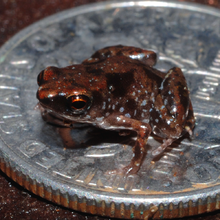

The smallest vertebrates (and smallest amphibians) known are Paedophryne amauensis frogs from Papua New Guinea, which range in length from 7.0–8.0 mm (0.28–0.31 in), and average 7.7 mm (0.30 in). Other very small frogs include:
- Brachycephalus didactylus from Brazil (reported as 9.6–9.8 mm (0.38–0.39 in))
- several species of Eleutherodactylus such as E. iberia (around 10 mm (0.39 in)) and E. limbatus (8.5–12 mm (0.33–0.47 in)) and Eleutherodactylus orientalis (12.5 mm (0.49 in)) from Cuba,
- Gardiner's Frog Sechellophryne gardineri from the Seychelles (up to 1 mm (0.039 in)),
- several species of Stumpffia such as S. tridactyla (8.6–12 mm (0.34–0.47 in)) and S. pygmaea (males 10–12.5 mm (0.39–0.49 in); females: 11 mm (0.43 in)) and Wakea madinika (males: 11–13 mm (0.43–0.51 in); females: 15–16 mm (0.59–0.63 in)) from Madagascar.
Paedophryne swiftorum (body length 8.5 mm (0.33 in)) is not included in the smallest vertebrates known with other nine species of frogs. The two species Microhyla borneensis (males: 10.6–13 mm (0.42–0.51 in); females: 16–19 mm (0.63–0.75 in)) and Arthroleptella rugosa (males: 11.9–14.1 mm (0.47–0.56 in); females: 15.5 mm (0.61 in)) were once the smallest known frogs from the Old World. In general these extremely small frogs occur in tropical forest and montane environments. There is relatively little data on size variation among individuals, growth from metamorphosis to adulthood or size variation among populations in these species. Additional studies and the discovery of further minute frog species are likely to change the rank order of this list.
Salamanders, newts and allies (Urodela)
The average snout-to-vent length (SVL) of several specimens of the salamander Thorius arboreus was 17 mm (0.67 in).
Sauropsids (Sauropsida)
Lizards and snakes (Squamata)

- The dwarf gecko (Sphaerodactylus ariasae) is the smallest known reptile species and smallest lizard, with a snout-vent length of 16 millimetres (0.63 in). S. ariasae was first described in 2001 by the biologists Blair Hedges and Richard Thomas. This dwarf gecko lives in Jaragua National Park in the Dominican Republic and on Beata Island (Isla Beata), off the southern coast of the Dominican Republic. A few Brookesia chameleons from Madagascar are equally small, with a reported snout-vent length of 15–18 mm (0.59–0.71 in) for male dwarf chameleons (B. minima), 14–19 mm (0.55–0.75 in) for male Mount d'Ambre leaf chameleons (B. tuberculata) and 15–16 mm (0.59–0.63 in) for male B. micra, though females are larger. In 2021, a new species of Brookesia, B. nana, was discovered, with a snout-vent length of 13.5 mm (0.53 in), possibly making it the smallest known reptile.

- One of the smallest known snakes is the recently discovered Barbados threadsnake (Leptotyphlops carlae). Adults average about 10 cm (4 in) long, which is only about twice as long as the hatchlings. The Common blind snake (Indotyphlops braminus) measures 5.1–10.2 cm (2–4 in) long, occasionally up to 15 cm (6 in) long.
Turtles and tortoises (Testudines)
The smallest turtle is the speckled padloper tortoise (Homopus signatus) from South Africa. The males measure 6–8 cm (2.4–3.1 in), while females measure up to almost 10 cm (3.9 in).
Archosaurs (Archosauria)
Crocodiles and close relatives (Crocodylomorpha)
- The smallest extant crocodilian is the Cuvier's dwarf caiman (Paleosuchus palpebrosus) from northern and central South America. It reaches up to 1.6 m (5.2 ft) in length.
- Some extinct crocodylomorphs were even smaller. Fully grown Bernissartia from the Early Cretaceous reached a bit more than 60 cm (24 in) in length.
- The Early Cretaceous terrestrial notosuchian Malawisuchus was no more than 60 cm (24 in) long. Other small notosuchians include Anatosuchus at 70 cm (28 in) and herbivorous Simosuchus at 75 cm (30 in).
Pterosaurs (Pterosauria)
Further information: Pterosaur sizeNemicolopterus was the smallest pterosaur, it reached about 25 cm (9.8 in) in wingspan.
Non-avian dinosaurs (Dinosauria)
Further information: Dinosaur sizeSizes of non-avian dinosaurs are commonly labelled with a level of uncertainty, as the available material often (or even usually) is incomplete. The smallest known extinct dinosaur is Anchiornis, a genus of feathered dinosaur that lived in what is now China during the Late Jurassic Period 160 to 155 million years ago. Adult specimens range from 34 cm (13 in) long, and the weight has been estimated at up to 110 g (3.9 oz). Parvicursor was initially seen as one of the smallest non-avian dinosaurs known from an adult specimen, at 39 cm (15 in) in length, and 162 g (5.7 oz) in weight. However, in 2022 its holotype was concluded to represent a juvenile individual. Epidexipteryx reached 25–30 cm (9.8–11.8 in) in length and 164–220 g (5.8–7.8 oz) in weight.
Birds (Aves)

- With a mass of approximately 1.95 grams (0.069 oz) and a length of 5.5 centimetres (2.2 inches), the bee hummingbird (Mellisuga helenae) is the smallest known dinosaur as well as the smallest bird species, and the smallest warm-blooded vertebrate. Called the zunzuncito in its native habitat on Cuba, it is lighter than a Canadian or U.S. penny. It is said that it is "more apt to be mistaken for a bee than a bird". The bee hummingbird eats half its total body mass and drinks eight times its total body mass each day. Its nest is 3 cm (1.2 in) across.
- The smallest waterfowl is pygmy goose (Nettapus). African species reaches the average weight of about 285 grams (10.1 oz) for males and 260 grams (9.2 oz) for females and wingspans between 142 millimetres (5.6 in) and 165 millimetres (6.5 in). The second smallest waterfowl is the extinct Mioquerquedula from the Miocene.
- The smallest penguin species is the little blue penguin (Eudyptula minor), which stands around 30–33 cm (12–13 in) tall and weighs 1.2–1.3 kg (2.6–2.9 lb).
- The smallest bird of prey is the Black-thighed falconet (Microhierax fringillarius), with a wingspan of 27–32 centimetres (11–13 in), roughly the size of a sparrow.
Non-mammalian synapsids (Synapsida)
The smallest Mesozoic mammaliaform was Hadrocodium with a skull of 1.5 cm (0.59 in) in length and a body mass of 2 g (0.071 oz).
Mammals (Mammalia)
Marsupials (Marsupialia)
The smallest marsupial is the long-tailed planigale from Australia. It has a body length of 110–130 millimetres (4.3–5.1 in) (including tail) and weigh 4.3 grams (0.15 oz) on average. The Pilbara ningaui is considered to be of similar size and weight.
Shrews (Eulipotyphla)
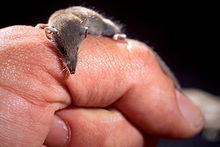
The Etruscan shrew (Suncus etruscus), is the smallest mammal by mass, weighing about 1.8 g (0.063 oz) on average. The smallest mammal that ever lived, the shrew-like Batodonoides vanhouteni, weighed 1.3 grams (0.046 oz).
Bats (Chiroptera)
The vulnerable Kitti's hog-nosed bat (Craseonycteris thonglongyai), also known as the bumblebee bat, from Thailand and Myanmar is the smallest mammal, at 29–33 millimetres (1.1–1.3 in) in length and 2 grams (0.071 oz) in weight.
Carnivorans (Carnivora)
The smallest member of the order Carnivora is the least weasel (Mustela nivalis), with an average body length of 114–260 mm (4.5–10.2 in). It weighs between 29.5–250 g (1.04–8.82 oz) with females being lighter.
Rodents (Rodentia)
The smallest known member of the rodent order is the Baluchistan pygmy jerboa, with an average body length of 4.4 cm (1.7 in).
Primates (Primates)
The smallest member of the primate order is Madame Berthe's mouse lemur (Microcebus berthae), found in Madagascar, with an average body length of 92 mm (3.6 in).
Cetaceans (Cetacea)
The smallest cetacean, which is also (as of 2006) the most endangered, is the vaquita, a species of porpoise. Male vaquitas grow to an average of around 135 cm (53 in); the females are slightly longer, averaging about 141 cm (56 in) in length.
Plants (Plantae)
Gymnosperms (Gymnospermae)
Zamia pygmaea is a cycad found in Cuba, and the smallest known gymnosperm. It grows to a height of 25 cm (10 in).
Angiosperms (Angiospermae)
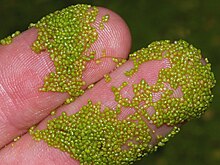
Duckweeds of the genus Wolffia are the smallest angiosperms. Fully grown, they measure 300 by 600 μm (0.30 by 0.60 mm) and reach a mass of just 150 µg.
Dicotyledons
The smallest known dicotyledon plant is the Himalayan dwarf mistletoe (Arceuthobium minutissimum). Shoots grow up to 5 mm (0.20 in) in height.
Other
Nanobes
Nanobes are thought by some scientists to be the smallest known organisms, about one tenth the size of the smallest known bacteria. Nanobes, tiny filamental structures first found in some rocks and sediments, were first described in 1996 by Philippa Uwins of the University of Queensland, but it is unclear what they are, and if they are alive.
See also
Notes
- Archosaurs are a clade within Sauropsida, but are significantly different from all other reptiles.
References
- Bennett, Gordon M.; Abbà, Simona; Kube, Michael; Marzachì, Cristina (25 February 2016). "Complete Genome Sequences of the Obligate Symbionts 'Candidatus Sulcia muelleri' and "Ca. Nasuia deltocephalinicola" from the Pestiferous Leafhopper Macrosteles quadripunctulatus (Hemiptera: Cicadellidae)". Genome Announcements. 4 (1): e01604–15. doi:10.1128/genomeA.01604-15. ISSN 2169-8287. PMC 4722273. PMID 26798106.
- "Pelagibacter ubique - microbewiki". microbewiki.kenyon.edu. Retrieved 19 April 2018.
- "Re: What is the smallest living thing?". Madsci.org. Retrieved 2013-10-03.
- P. Forterre (2012). "The virocell concept and environmental microbiology". The ISME Journal. 7 (2): 233–236. doi:10.1038/ismej.2012.110. PMC 3554396. PMID 23038175.
- Sanger, F.; Air, G. M.; Barrell, B. G.; Brown, N. L.; Coulson, A. R.; Fiddes, J. C.; Hutchison, C. A.; Slocombe, P. M.; Smith, M. (1977). "Nucleotide sequence of bacteriophage ΦX174 DNA". Nature. 265 (5596): 687–95. Bibcode:1977Natur.265..687S. doi:10.1038/265687a0. PMID 870828. S2CID 4206886.
- Finsterbusch T, Mankertz A (2009). "APorcine circoviruses--small but powerful". Virus Research. 143 (2): 177–183. doi:10.1016/j.virusres.2009.02.009. PMID 19647885.
- ICTVdB Virus Description – 00.016.0.01.005. Porcine circovirus 2 Archived July 4, 2007, at the Wayback Machine
- K. Rosario; R.O. Schenck; R.C. Harbeitner; S.N. Lawler; M. Breitbart (2015). "Novel circular single-stranded DNA viruses identified in marine invertebrates reveal high sequence diversity and consistent predicted intrinsic disorder patterns within putative structural proteins". Frontiers in Microbiology. 6: 696. doi:10.3389/fmicb.2015.00696. PMC 4498126. PMID 26217327.
- J.M. Labonté; C.A. Suttle (2013). "Previously unknown and highly divergent ssDNA viruses populate the oceans". The ISME Journal. 7 (11): 2169–2177. doi:10.1038/ismej.2013.110. PMC 3806263. PMID 23842650.
- "Enterobacteria phage BZ13 strain T72, complete genome". 2008.
- Coffin JM, Hughes SH, Varmus HE, eds. (1997). "Table 2: Sizes of Retroviral LTR Components (U3-R-U5) and Genomes". Retroviruses. Cold Spring Harbor Laboratory Press. ISBN 0-87969-571-4.
- Fiala, Ivan. 2008. Myxozoa. Version 10 July 2008 (under construction). http://tolweb.org/Myxozoa/2460/2008.07.10 in The Tree of Life Web Project, http://tolweb.org/
- Kaur, H; Singh, R (2011). "Two new species of Myxobolus (Myxozoa: Myxosporea: Bivalvulida) infecting an Indian major carp and a cat fish in wetlands of Punjab, India". J Parasit Dis. 35 (2): 169–76. doi:10.1007/s12639-011-0061-4. PMC 3235390. PMID 23024499.
- Abele, Doris; Brey, Thomas; Philipp, Eva (15 February 2017). "Part N, Revised, Volume 1, Chapter 7: Ecophysiology of Extant Marine Bivalvia". Treatise Online. doi:10.17161/to.v0i0.6583.
- Páll-Gergely, Barna; Hunyadi, András; Jochum, Adrienne; Asami, Takahiro (28 September 2015). "Seven new hypselostomatid species from China, including some of the world's smallest land snails (Gastropoda, Pulmonata, Orthurethra)". ZooKeys (523): 31–62. doi:10.3897/zookeys.523.6114. PMC 4602296. PMID 26478698.
- Sankar-Gorton, Eliza (4 November 2015). "Newly Discovered Land Snail Is The Tiniest In The World". HuffPost. Retrieved 9 November 2015.
- Geggel, Laura (2 November 2015). "Micro Mollusk Breaks Record for World's Tiniest Snail". LiveScience. Retrieved 8 November 2015.
- Páll-Gergely, Barna; Hunyadi, András; Jochum, Adrienne; Asami, Takahiro (2015). "Seven new hypselostomatid species from China, including some of the world's smallest land snails (Gastropoda, Pulmonata, Orthurethra)". ZooKeys (523): 31–62. doi:10.3897/zookeys.523.6114. PMC 4602296. PMID 26478698.
- Nishiguchi MK, Mapes R (2008). "Cephalopoda". In Ponder W, Lindberg D (eds.). Phylogeny and Evolution of the Mollusca (PDF). University of California Press. pp. 162–199.
- ^ "Smallest spider". Guinness World Records. Retrieved 2021-04-16.
- Huber, John; Noyes, John (2013-04-24). "A new genus and species of fairyfly, Tinkerbella nana (Hymenoptera, Mymaridae), with comments on its sister genus Kikiki, and discussion on small size limits in arthropods". Journal of Hymenoptera Research. 32: 17–44. doi:10.3897/jhr.32.4663. ISSN 1314-2607.
- "Meet the mite, the tiny bugs in your mattress, your tea and on your face". PBS NewsHour. 2016-09-02. Retrieved 2021-04-16.
- Joel W. Martin & George E. Davis (2001). An Updated Classification of the Recent Crustacea (PDF). Natural History Museum of Los Angeles County. pp. 132 pp. Archived from the original (PDF) on October 10, 2008.
- "University of Florida Book of Insect Records". Entnemdept.ifas.ufl.edu. 1998-04-17. Archived from the original on 2013-10-05. Retrieved 2013-10-03.
- Polilov, A.A. (2015). "How small is the smallest? New record and remeasuring of Scydosella musawasensis Hall, 1999 (Coleoptera, Ptiliidae), the smallest known free-living insect". ZooKeys (526): 61–64. doi:10.3897/zookeys.526.6531. PMC 4607844. PMID 26487824.
- "Facts on the Western Pygmy Blue Butterfly".
- Rao, G. Chandrasekhara (1968). "On Psammothuria ganapatii n. gen. n. sp., an interstitial holothurian from the beach sands of waltair coast and its autecology". Proceedings of the Indian Academy of Sciences, Section B. 67 (5): 201–206. doi:10.1007/BF03053902. S2CID 135202924.
- ^ Gilpin, Daniel (2006). Starfish, urchins, and other echinoderms. London: David West Children's Books. p. 41. ISBN 0-7565-1611-0.
- Froese, Rainer; Pauly, Daniel (eds.). "Paedocypris progenetica". FishBase. September 2017 version.
- "Fishes". The Australian Museum. June 2020. Archived from the original on October 3, 2022. Retrieved February 14, 2019.
- Froese, Rainer; Pauly, Daniel (eds.). "Schindleria brevipinguis". FishBase. September 2017 version.
- "Scientists find 'smallest fish'". BBC News. 2006-01-25. Retrieved 2010-05-23.
- "What is the smallest species of fish?". Amonline.net.au. 2013-09-27. Archived from the original on February 20, 2009. Retrieved 2013-10-03.
- "Smallest fish compete for honours". BBC News. 2006-01-31. Retrieved 2010-05-23.
- "Bragging Rights: The Smallest Fish Ever | LiveScience". Live Science. Archived from the original on July 6, 2008.
- "World's tiniest frogs found in Papua New Guinea". The Australian. 12 January 2012. Retrieved 11 January 2012.
- Rittmeyer, Eric N.; Allison, Allen; Gründler, Michael C.; Thompson, Derrick K.; Austin, Christopher C. (2012). "Ecological guild evolution and the discovery of the world's smallest vertebrate". PLOS ONE. 7 (1): e29797. Bibcode:2012PLoSO...729797R. doi:10.1371/journal.pone.0029797. PMC 3256195. PMID 22253785.
- Krishna Ramanujan (2012-03-29). "Student researchers help discover world's smallest frog". Cornell Chronicle. Retrieved 2012-01-03.
- "Tiny, new, pea-sized frog is old world's smallest". ScienceDaily.
- "Bornean Chorus Frog - Microhyla borneensis (Microhyla nepenthicola)". ecologyasia.com.
- Pennsylvania State University (2001). World's Smallest Lizard Discovered in the Caribbean. Retrieved 26 January 2009.
- "Tiny gecko is 'world's smallest'". BBC News. 2001-12-03. Retrieved 2010-05-23.
- "12/03/01 -- World's Smallest Reptile Discovered in Caribbean". Archived from the original on 2002-11-04. Retrieved 2011-12-14.
- Glaw, F., & Vences, M. (2007). A Field Guide to the Amphibians and Reptiles of Madagascar, 3d edition. Frosch Verlag. ISBN 978-3-929449-03-7
- Glaw, F.; Köhler, J. R.; Townsend, T. M.; Vences, M. (2012). Salamin, Nicolas (ed.). "Rivaling the World's Smallest Reptiles: Discovery of Miniaturized and Microendemic New Species of Leaf Chameleons (Brookesia) from Northern Madagascar". PLOS ONE. 7 (2): e31314. Bibcode:2012PLoSO...731314G. doi:10.1371/journal.pone.0031314. PMC 3279364. PMID 22348069.
- Glaw, Frank; Köhler, Jörn; Hawlitschek, Oliver; Ratsoavina, Fanomezana M.; Rakotoarison, Andolalao; Scherz, Mark D.; Vences, Miguel (2021-01-28). "Extreme miniaturization of a new amniote vertebrate and insights into the evolution of genital size in chameleons". Scientific Reports. 11 (1): 2522. doi:10.1038/s41598-020-80955-1. ISSN 2045-2322. PMC 7844282. PMID 33510189.
- "World's Smallest Chameleon Discovered And It's 'Surprisingly' Well-Endowed". IFLScience. Retrieved 2021-01-28.
- "Indotyphlops braminus :: Florida Museum of Natural History". floridamuseum.ufl.edu. 17 August 2020.
- "Blind Snakes". reptilesmagazine.com. December 2011.
- Branch, B. (1998). Field Guide to Snakes and other Reptiles of Southern Africa. 3d edition. Struik Publishers. ISBN 1-86872-040-3
- "Paleosuchus palpebrosus (Cuvier, 1807)". Archived from the original on 13 October 2007.
- Godoy PL, Benson RB, Bronzati M, Butler RJ (2019). "The multi-peak adaptive landscape of crocodylomorph body size evolution". BMC Evolutionary Biology. 19 (167): 167. doi:10.1186/s12862-019-1466-4. PMC 6686447. PMID 31390981.
- Martin JE, Smith T, Salaviale C, Adrien J, Delfino M (2020). "Virtual reconstruction of the skull of Bernissartia fagesii and current understanding of the neosuchian-eusuchian transition" (PDF). Journal of Systematic Palaeontology. 18 (13): 1079–1101. doi:10.1080/14772019.2020.1731722. ISSN 1477-2019. S2CID 216464226.
- Gomani, Elizabeth M. (1997). "A crocodyliform from the Early Cretaceous Dinosaur Beds, northern Malawi". Journal of Vertebrate Paleontology. 17 (2): 280–294. doi:10.1080/02724634.1997.10010975.
- Sereno PC, Sidor CA, Larsson HC, Gado B (June 2003). "A new notosuchian from the Early Cretaceous of Niger". Journal of Vertebrate Paleontology. 23 (2): 477–482. doi:10.1671/0272-4634(2003)023[0477:ANNFTE]2.0.CO;2. S2CID 86329307 – via ResearchGate.
- Michael J. Benton (2015). Vertebrate Palaeontology. John Wiley & Sons, Ltd. p. 249. ISBN 9781118407554. Retrieved 25 September 2022.
- Wang, X.; Kellner, A.W.A.; Zhou, Z.; Campos, D.A. (2008). "Discovery of a rare arboreal forest-dwelling flying reptile (Pterosauria, Pterodactyloidea) from China". Proceedings of the National Academy of Sciences. 105 (6): 1983–1987. Bibcode:2008PNAS..105.1983W. doi:10.1073/pnas.0707728105. PMC 2538868. PMID 18268340.
- Xu, X., Zhao, Q., Norell, M., Sullivan, C., Hone, D., Erickson, G., Wang, X., Han, F. and Guo, Y. (2009). "A new feathered maniraptoran dinosaur fossil that fills a morphological gap in avian origin." Chinese Science Bulletin, 6 pages, accepted November 15, 2008.
- Which was the smallest dinosaur? Archived 2011-07-06 at the Wayback Machine Royal Tyrrell Museum. Last accessed 2008-05-23.
- Averianov AO, Lopatin AV (2022). "A re-appraisal of Parvicursor remotus from the Late Cretaceous of Mongolia: implications for the phylogeny and taxonomy of alvarezsaurid theropod dinosaurs". Journal of Systematic Palaeontology. 19 (16): 1097–1128. doi:10.1080/14772019.2021.2013965. S2CID 247222017.
- Zhang, F.; Zhou, Z.; Xu, X.; Wang, X.; Sullivan, C. (2008). ""A bizarre Jurassic maniraptoran from China with elongate ribbon-like feathers", Supplementary Information". Nature. 455 (7216): 1105–8. Bibcode:2008Natur.455.1105Z. doi:10.1038/nature07447. PMID 18948955. S2CID 4362560.
- Paul, Gregory S. (2016). The Princeton Field Guide to Dinosaurs. Princeton University Press. p. 139. ISBN 978-1-78684-190-2. OCLC 985402380.
- "mschloe.com - Diese Website steht zum Verkauf! - Informationen zum Thema mschloe". ww1.mschloe.com. Archived from the original on July 3, 2013.
- Kear, Janet (2005). Ducks, Geese and Swans: Species accounts (Cairina to Mergus) [Volume 2 of Ducks, Geese and Swans: Species accounts]. Oxford: Oxford University Press. p. 908. ISBN 9780198610090.
- "Dabbling Ducks (Aves: Anatidae) from the Middle Miocene of Mongolia". ResearchGate. October 2018.
- Grabski, Valerie (2009). "Little Penguin – Penguin Project". Penguin Sentinels/University of Washington. Archived from the original on 16 December 2011. Retrieved 24 September 2022.
- Raptors of the World by Ferguson-Lees, Christie, Franklin, Mead & Burton. Houghton Mifflin (2001)828-829, ISBN 0-618-12762-3
- T. S. Kemp (2005). The Origin and Evolution of Mammals. Oxford University Press, USA. p. 183. ISBN 9780198507611. Retrieved 22 September 2022.
- ^ "World's Smallest Animals". Thetoptenz.net. 2013-09-29. Retrieved 2013-10-03.
- Jürgens, Klaus D. (August 2002). "Etruscan shrew muscle: the consequences of being small". Journal of Experimental Biology. 205 (15): 2161–2166. doi:10.1242/jeb.205.15.2161. PMID 12110649. Retrieved April 27, 2020.
- Bloch, Jonathan I.; Rose, Kenneth D.; Gingerich, Philip D. (1998). "New Species of Batodonoides (Lipotyphla, Geolabididae) from the Early Eocene of Wyoming: Smallest Known Mammal?". Journal of Mammalogy. 79 (3): 804–827. doi:10.2307/1383090. JSTOR 1383090.
- Bates, P.; Bumrungsri, S. & Francis, C. (2008). "Craseonycteris thonglongyai". IUCN Red List of Threatened Species. 2008: e.T5481A11205556. doi:10.2305/IUCN.UK.2008.RLTS.T5481A11205556.en. Listed as Vulnerable
- Donati, Annabelle, and Pamela Johnson. "Which mammal is the smallest?." I wonder which snake is the longest: and other neat facts about animal records. Racine, Wis.: Western Pub. Co., 1993. 8. Print.
- "Bumblebee bat (Craseonycteris thonglongyai)". EDGE Species. Archived from the original on 21 September 2010. Retrieved 2008-04-10.
- (Retrieved on March 17, 2010). Archived July 16, 2009, at the Wayback Machine
- Bhatnagar, S. P.; Moitra, Alok (1996). Gymnosperms. New Age International. ISBN 978-81-224-0792-1. Retrieved 16 April 2022.
- P.S.Dhami; G.Chopra; H.N.Srivastava (2015). A textbook of Biology. Jalandhar, Punjab: Pradeep Publication.
- "What is the smallest flower in the world?". Loc.gov. Retrieved 2013-10-03.
- Datta, R. M. (February 1951). "Occurrence of a Hermaphrodite Flower in Arceuthobium minutissimum Hook. f., the Smallest Known Dicotyledonous Plant". Nature. 167 (4240): 203–204. Bibcode:1951Natur.167..203D. doi:10.1038/167203a0. ISSN 1476-4687. PMID 14806428. S2CID 4181798. Retrieved 16 April 2022.
- Nanjundiah, V. (2000). "The smallest form of life yet?" (PDF). Journal of Biosciences. 25 (1): 9–10. doi:10.1007/BF02985175. PMID 10824192. S2CID 29030837.
External links
- Featherwing beetles on the UF / IFAS Featured Creatures Web site